Editorial: Maximum Street Speed Explained

Let us begin with this: it is possible to go much faster on North American public roads than the law allows. Much faster. If you are interested in exploring the upper limits of this possibility, read on. If you find this idea morally, legally, ethically or spiritually repugnant; please return to your regularly scheduled bailout coverage. If you’re a member of law enforcement, please consider this a work of fiction.
In theory, I’ve been driving “too fast” on public roads for more than twenty years. In that time, I may have learned a lot about what works and what does not. I will share this hypothetical knowledge—bought and paid for in terror, twisted steel and sleepless nights—with you. Or not.
Before we begin, a caveat. The fast-road driver needs more than skill, more than training, more than a fast car. He (and it is almost always he) needs luck. Luck eventually runs out. When that happens, people get hurt. Sometimes innocent people get hurt—if any of us are truly “innocent” in this world. Sometimes the driver will go to jail or beyond that to the penitentiary. Sometimes people die. You have been warned.
To drive truly quickly, you will need a level of preparation and skill roughly equivalent to what is found in NASA’s Time Trial class. Your car needs to have its fluids at the appropriate levels, its tire pressures checked and its suspension components torqued. Your tires need full tread, no plugs, no camber wear.
You, as the driver, need to be alert, sober, rested, and ready to look all the way down the road. The trained fast-road driver scans the horizon and looks to the end of his available vision. That’s where the cops are, that’s where the accidents happen, that’s where you start to intuit the movement patterns of your fellow drivers. Practice identifying cars in the oncoming freeway lanes as soon as they are visible. At any time, you should be able to close your eyes and recite the makes and models of the cars around you.
We’ll use a limited set of the race driver’s toolkit in our pursuit of maximum street speed. Trail-braking is out, deliberate contact is out, drafting is out. Instead, we follow the old Bondurant curriculum. All braking is done in a straight line, every time. If you have ABS, don’t be afraid to engage it. We never steer and brake simultaneously, particularly on the freeway. We don’t accelerate out of turns with the steering wheel “pinched” and we use formula-car hand positioning on the wheel. No shuffle-steer. Ever. This isn’t autocross. Get the wheel straight and put your right foot all the way down.
Traction control is left on at all times, with the exception of when we need a Jarno Donut (to be covered later). Turn the radio down or off. Sit close enough to the wheel that your wrist falls naturally on the rim of the wheel. If you have a CG-Lock, you can left-foot brake. If you don’t, don’t, because when you panic-brake from high speeds you will have nothing to keep your body in the seat. Get your heel-and-toe together, pronto. And for God’s sake, put your seatbelt on because you’ll eventually need it.
We’ll start with freeways. Speeding on the freeway is easy. Anybody can do it. The trick is in maintaining a consistent pace of twice the pack speed or higher. To do this we extend our vision to the horizon as mentioned above and watch the cars ahead. Look for lane changes, look for shifts in traffic, look for drivers who are slow, distracted or wobbly. Most of our passing is done to the right. This offends wanna-be Autobahn drivers, but we don’t care.
Cops expect you to speed in the left lane and they tend to look down the left lane. Stay to the right. Truck convoys are the exception. They will punish you for right-lane passes.
Our passing method is simple. We come up on a car-to-be-passed from directly behind. We do this to attract the driver’s attention into his rear-view mirror. When we are two hundred feet behind, we change lanes (to the right, if possible) and pass as far away as possible. While we prepare the pass, we look at the adjacent lane and we have a backup plan in case the car we are passing wobbles.
If there is no lane, evaluate the shoulder for heavy marbles, dirt, obstacles. If we see those, we dial back the speed to 100mph or less. Get in the habit of driving on the shoulder. We learn to drive on the shoulder because we’ll have to do it many times in the future, both to avoid panic-swerves and to pass recalcitrant lane-blockers.
In Part II, we’ll discuss night freeway driving and basic evasion techniques.

More by Jack Baruth
Latest Car Reviews
Read moreLatest Product Reviews
Read moreRecent Comments
- Jrhurren Worked in Detroit 18 years, live 20 minutes away. Ren Cen is a gem, but a very terrible design inside. I’m surprised GM stuck it out as long as they did there.
- Carson D I thought that this was going to be a comparison of BFGoodrich's different truck tires.
- Tassos Jong-iL North Korea is saving pokemon cards and amibos to buy GM in 10 years, we hope.
- Formula m Same as Ford, withholding billions in development because they want to rearrange the furniture.
- EV-Guy I would care more about the Detroit downtown core. Who else would possibly be able to occupy this space? GM bought this complex - correct? If they can't fill it, how do they find tenants that can? Is the plan to just tear it down and sell to developers?


































Comments
Join the conversation
quite often the only way to pass is using right lane, reason folks will hog up middle & left lane at the speed limit or 10 mph above, u cant go anywhere thats all, only right lane is open.
[...] himself claims experience with regards to speed – his “Maximum Street Speed Explained” series was an interesting editorial to say the least – and comes to a conclusion, in spite of [...]